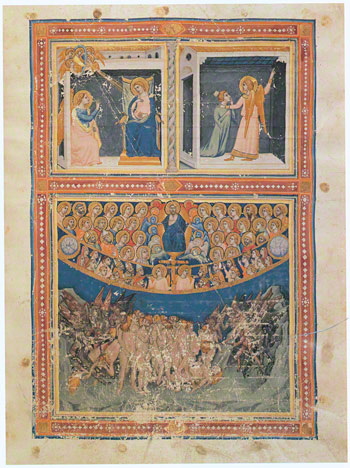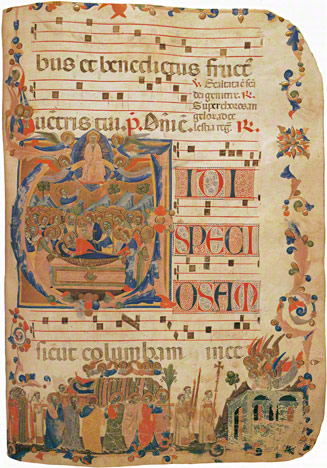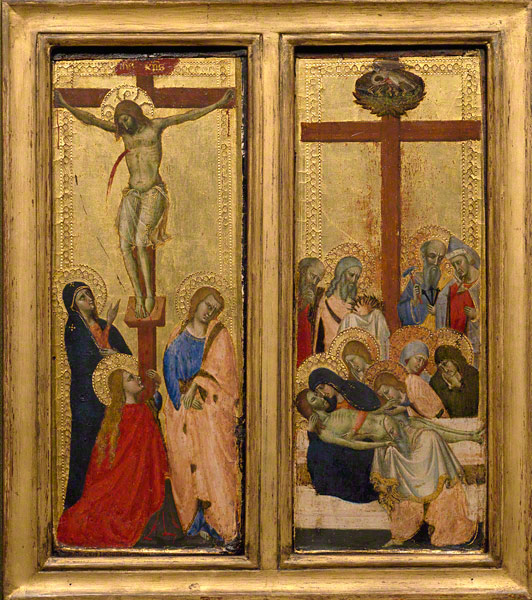Pacino di Bonaguida and His Collaborators
The workshop formed the foundation for artistic production in 14th-century Italy. From this environment emerged the figure of Pacino di Bonaguida, active in Florence from around 1300 until well into the 1340s. The great volume of works attributed to Pacino di Bonaguida necessitated the involvement of numerous artists working in his style within a workshop. Together, these artists dominated Florentine illumination in the first half of the 14th century.
Collaboration on Manuscripts
The images below are from an elaborately decorated five-volume choir book made for a church in the Tuscan city of Impruneta. To complete such a large project, it was illuminated by several members of Pacino di Bonaguida's workshop in collaboration with other artists.


The impressive full-page illumination by Pacino, above at left, shows three scenes related to the theme of Christian salvation at the end of time. The Last Judgment, in the lower half of the page, was rarely represented in manuscript illumination in the first half of the 14th century, and thus Pacino's treatment of the crowded composition is quite novel and displays his artistic creativity.
The illumination above at right is by Pacino's collaborator, the Master of the Dominican Effigies. This artist drew inspiration for these scenes of the Virgin Mary's death and assumption into heaven (both shown in the illuminated letter V in the center of the page) from panel paintings by Giotto and Bernardo Daddi, respectively. The closely packed compositions, minute attention to facial features and expressions, and vibrant colors are typical of this artist's style.
The illumination above at right is by Pacino's collaborator, the Master of the Dominican Effigies. This artist drew inspiration for these scenes of the Virgin Mary's death and assumption into heaven (both shown in the illuminated letter V in the center of the page) from panel paintings by Giotto and Bernardo Daddi, respectively. The closely packed compositions, minute attention to facial features and expressions, and vibrant colors are typical of this artist's style.
Master of the Dominican Effigies
Like Pacino, the Master of the Dominican Effigies, so named after a panel painting he produced depicting Christ and the Virgin Mary surrounded by seventeen Dominican saints (and on view in this exhibition), was accomplished in both panel painting and manuscript illumination. It is unclear whether the artist worked in Pacino's workshop or if he operated his own studio.

The Master of the Dominican Effigies' work is characterized by compact, carefully arranged compositions and figures with swarthy skin tones and close-set facial features. While his style complemented Pacino's in their collaborative commissions, it is distinctive from that of artists who worked in Pacino's style, marking the anonymous artist as an established master in his own right.
The two scenes above related to Christ's death display tightly packed and emotion-filled compositions typical of the Master of the Dominican Effigies. These panels were likely the lower parts of the left and right wings of a small altarpiece that would have displayed additional images.
The two scenes above related to Christ's death display tightly packed and emotion-filled compositions typical of the Master of the Dominican Effigies. These panels were likely the lower parts of the left and right wings of a small altarpiece that would have displayed additional images.
Publication
Florence at the Dawn of the Renaissance: Painting and Illumination 1300–1350
Edited by Christine Sciacca
Edited by Christine Sciacca
Related Information
At the Art Gallery of Ontario
- Revealing the Renaissance: Stories and Secrets in Early Florentine Art
March 16–June 16, 2013

